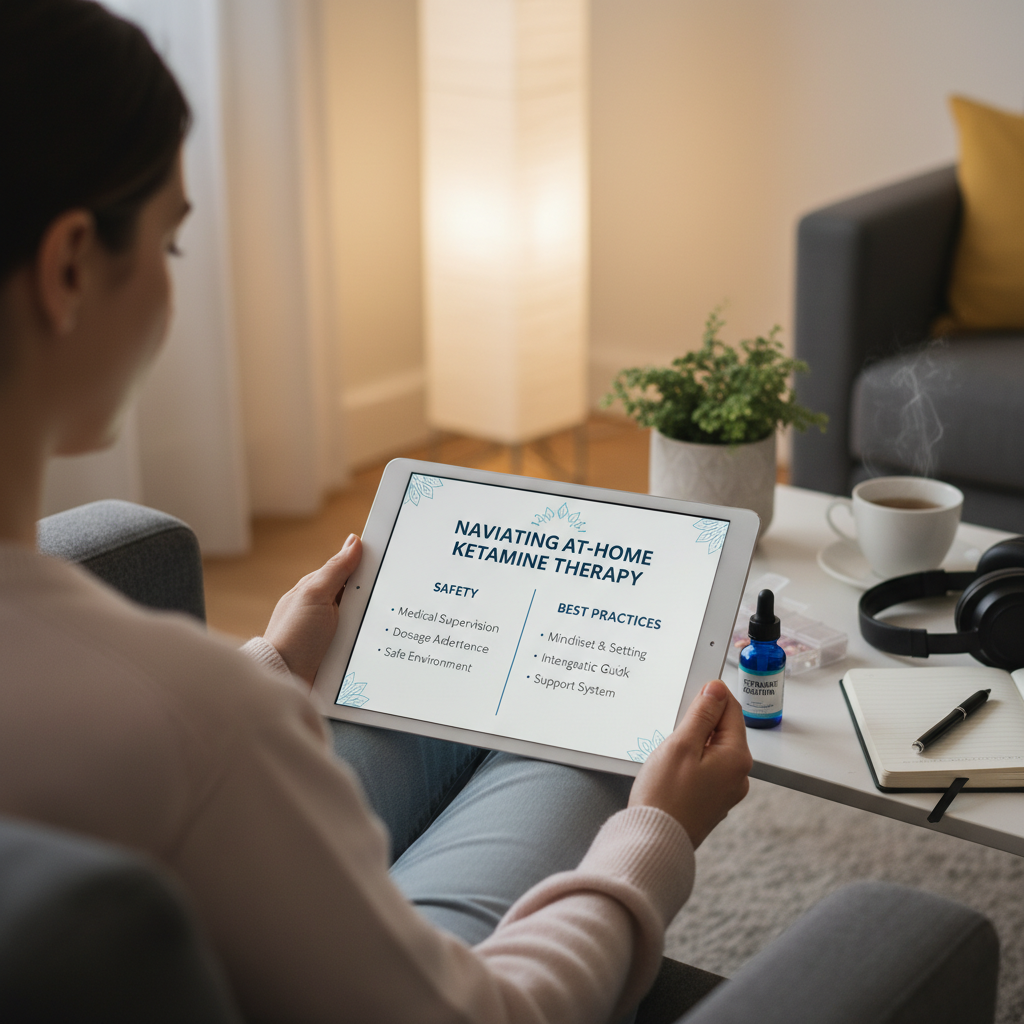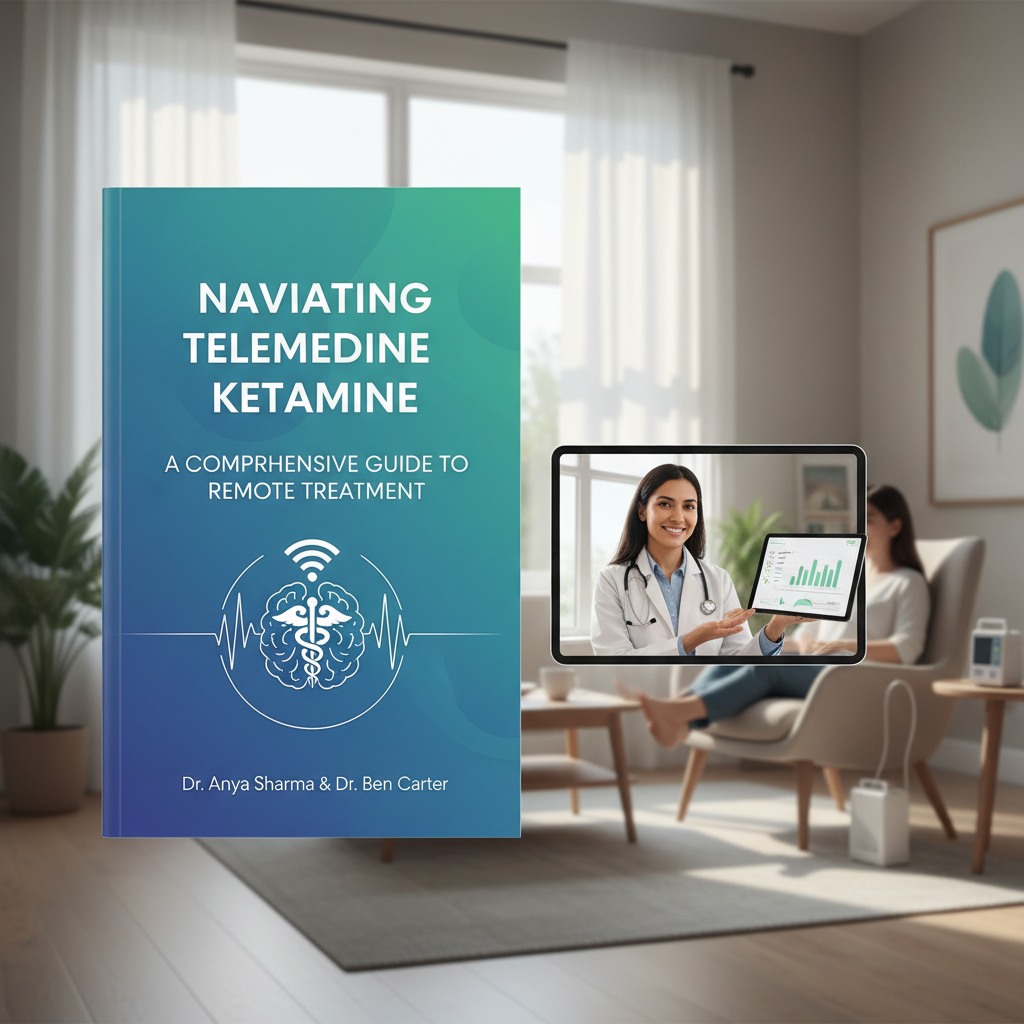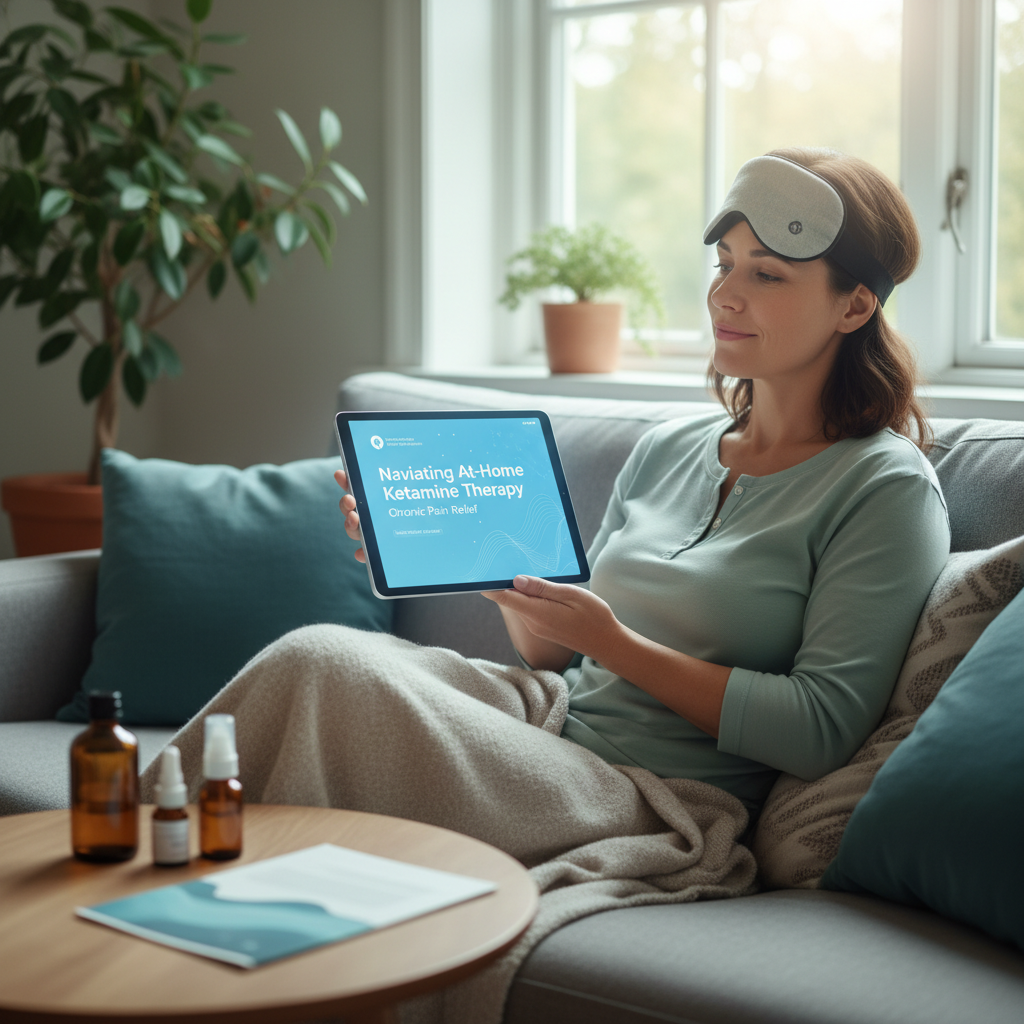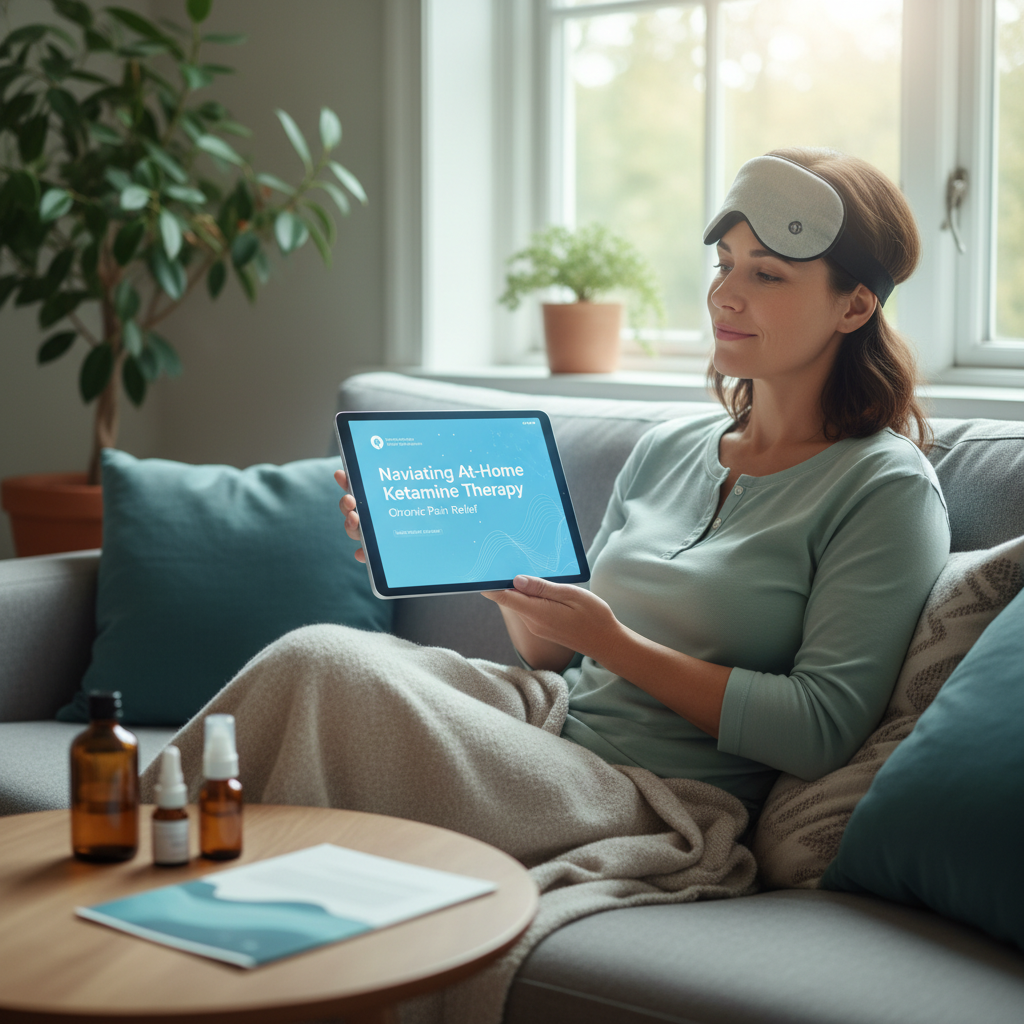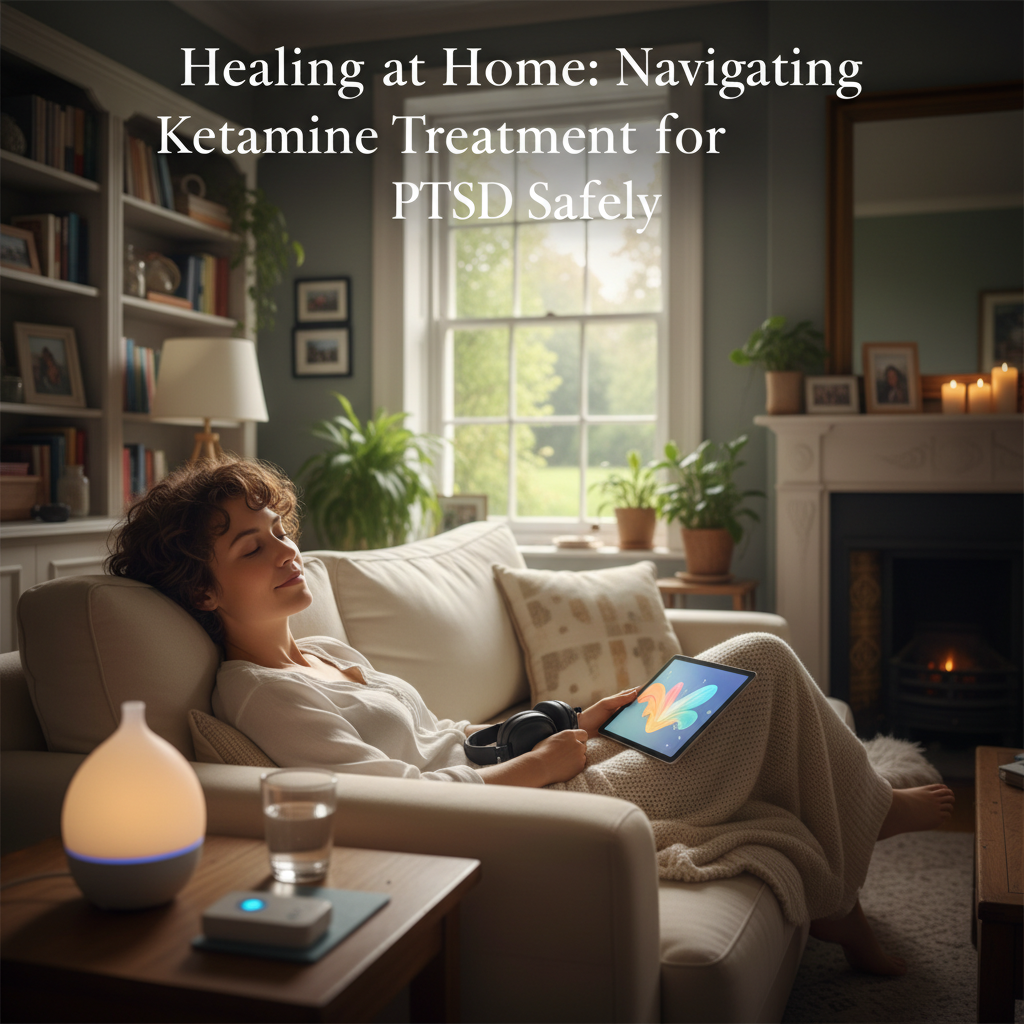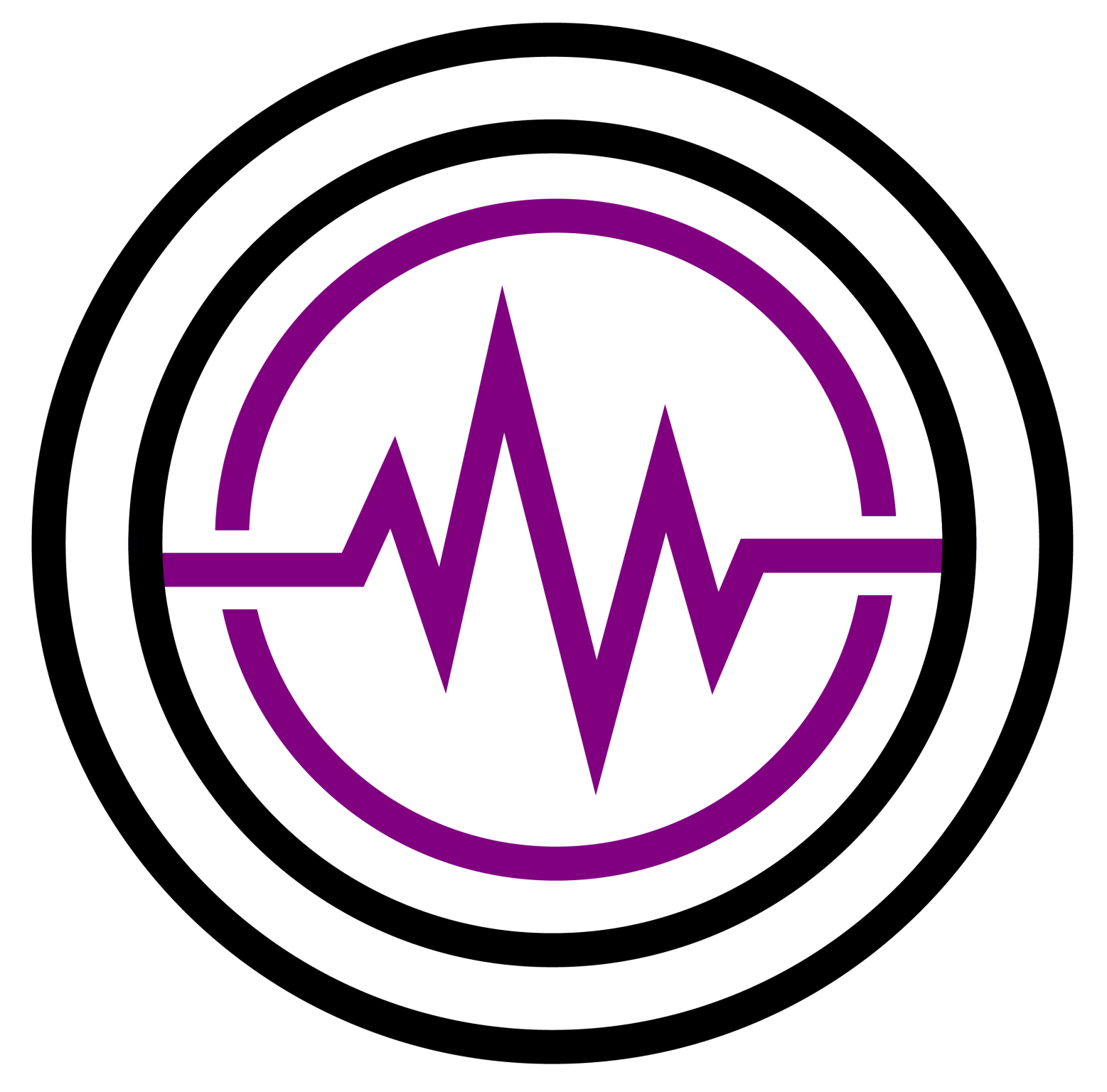A Comprehensive Guide to Understanding, Risks, and Benefits
Quick Summary / Key Takeaways
- At-home ketamine therapy offers a potential breakthrough for chronic pain sufferers, especially when traditional treatments have failed to provide adequate relief.
- Strict medical supervision, proper screening, and adherence to safety protocols are paramount to ensure the safe and effective administration of at-home ketamine.
- Individualized treatment plans are crucial, considering variations in dosage, administration methods (e.g., sublingual, nasal spray), and frequency based on patient needs.
- Patients often experience significant reductions in pain and improvements in mood, but outcomes are highly individualized and require realistic expectations.
- Understanding and preparing for potential side effects, such as temporary dissociation, nausea, or dizziness, is an essential part of the at-home ketamine experience.
Introduction
Chronic pain casts a long, relentless shadow over millions of lives, often leaving sufferers feeling isolated and hopeless as traditional treatments fall short. Imagine waking up each day facing a relentless ache or nerve fire, slowly eroding your quality of life, productivity, and joy. It’s a reality far too many endure, often battling multiple medications with diminishing returns and debilitating side effects. Enter ketamine, a medication traditionally used as an anesthetic, now emerging as a promising—albeit unconventional—therapy for recalcitrant chronic pain and related mood disorders. While once confined to specialized clinics, the landscape is shifting, with at-home ketamine treatments gaining traction and offering a new beacon of hope. This guide delves deep into the world of at-home ketamine for chronic pain, offering a balanced perspective on its potential, the critical safety measures, and what patients can realistically expect. It’s about empowering you with knowledge, navigating the nuances, and understanding if this innovative approach could be a viable path toward reclaiming your life from the grip of chronic pain.
At-Home Ketamine Administration Methods Comparison
| Method | Typical Onset Time | Duration of Effects | Common Use Cases |
|---|---|---|---|
| Sublingual Lozenge | 15-30 minutes | 60-90 minutes | General chronic pain, mood disorders |
| Intranasal Spray | 5-15 minutes | 45-60 minutes | Acute pain flares, rapid relief needs |
| Rectal Suppository | 20-40 minutes | 90-120 minutes | Steady absorption, longer pain relief |
| Oral Capsule/Troche | 30-60 minutes | 60-120 minutes | Maintenance therapy, specific pain types |
Potential Benefits vs. Risks of At-Home Ketamine Therapy
| Aspect | Key Potential Benefit | Key Potential Risk | Crucial Consideration |
|---|---|---|---|
| Pain Relief | Significant reduction in neuropathic and chronic pain | Inconsistent results, not effective for all | Individual response varies; supervision is key |
| Mental Health | Alleviation of depression and anxiety comorbid with pain | Temporary dissociation, psychological distress | Proper set/setting and integration support |
| Convenience | Access to therapy from comfort of one’s home | Risk of improper use without supervision | Requires disciplined adherence to protocols |
| Long-Term Use | Sustainable pain management with reduced medication reliance | Urinary tract issues, dependence potential | Regular monitoring and reassessment by provider |
Application Preparation Checklist
- Complete thorough medical screening with a qualified provider specializing in ketamine therapy.
- Establish a safe, private, and distraction-free treatment environment at home.
- Ensure a trusted, sober adult is present during each session for safety and support, if required.
- Understand all emergency protocols and have contact information for your medical team readily available.
Post-Arrival Checklist
- Document post-session experiences, including pain levels, mood shifts, and any side effects.
- Adhere strictly to your follow-up schedule with your supervising medical team for dosage adjustments.
- Practice integration techniques, such as journaling or mindfulness, to process session insights.
- Report any adverse side effects, new symptoms, or persistent concerns promptly to your provider.
Table of Contents
Section 1: Understanding Ketamine & Chronic Pain
- What is ketamine and how does it help chronic pain?
- How is at-home ketamine different from traditional ketamine clinics?
- Who is a suitable candidate for at-home ketamine therapy?
Section 2: The At-Home Therapy Process
- What is the typical process for starting at-home ketamine treatment?
- How is ketamine administered in an at-home setting?
- What safety precautions must be taken during at-home sessions?
- How are dosages determined and adjusted for chronic pain?
Section 3: Safety & Side Effects
- What are the potential side effects of at-home ketamine?
- Are there any long-term risks associated with at-home ketamine use?
- How does at-home ketamine therapy impact mental health?
- What should I do if I experience an adverse reaction during a session?
Section 4: Effectiveness & Expectations
- How effective is at-home ketamine for various types of chronic pain?
- How long does it take to feel the effects of at-home ketamine therapy?
Section 5: Navigating the Future
- What role does integration play in maximizing benefits from at-home ketamine?
- How can I find a reputable provider for at-home ketamine therapy?
Frequently Asked Questions
Section 1: Understanding Ketamine & Chronic Pain
FAQ 1: What is ketamine and how does it help chronic pain?
Ketamine is a dissociative anesthetic that, at sub-anesthetic doses, modulates N-methyl-D-aspartate (NMDA) receptors in the brain, which are implicated in pain signaling and neuroplasticity. This modulation helps ‘reset’ hypersensitive pain pathways and can also increase beneficial neurotransmitters like glutamate, leading to pain relief and mood elevation. It can disrupt the chronic pain cycle by impacting pain processing centers and reducing inflammation, offering a unique mechanism of action compared to traditional analgesics. Its neuroplastic effects may help the brain form new, healthier connections. Many find it effective where opioids and NSAIDs fail.
FAQ 2: How is at-home ketamine different from traditional ketamine clinics?
At-home ketamine therapy typically involves self-administration of lower doses via sublingual lozenges or nasal sprays, supervised remotely by a medical professional. In contrast, traditional ketamine clinics often administer higher doses intravenously (IV) under direct, in-person medical observation. At-home therapy emphasizes convenience and lower cost, while clinic-based treatments offer more immediate medical intervention for potential side effects. Both methods aim to achieve therapeutic effects but differ significantly in setting, administration, and intensity of immediate oversight. Remote monitoring and patient education are key in the at-home model.
FAQ 3: Who is a suitable candidate for at-home ketamine therapy?
Suitable candidates for at-home ketamine therapy are typically individuals with chronic neuropathic pain, complex regional pain syndrome (CRPS), or severe depression unresponsive to conventional treatments, who have been thoroughly screened by a medical professional. They must be physically and mentally stable, without contraindications like uncontrolled high blood pressure, severe heart conditions, or a history of psychosis. Additionally, candidates should have a supportive home environment, access to a trusted sober adult during sessions, and the ability to comply with remote monitoring protocols. A strong commitment to the treatment plan is essential for success.
Section 2: The At-Home Therapy Process
FAQ 4: What is the typical process for starting at-home ketamine treatment?
The typical process begins with a comprehensive medical and psychological evaluation by a qualified provider to assess suitability and rule out contraindications. If approved, the provider creates a personalized treatment plan, including dosage and administration method, and the medication is then mailed to the patient’s home. Before the first session, patients receive detailed instructions on preparation, administration, and safety protocols, often including the requirement of a sober sitter. Regular virtual check-ins with the medical team are scheduled to monitor progress and adjust the treatment plan as needed. This ensures safety and effectiveness.
FAQ 5: How is ketamine administered in an at-home setting?
In an at-home setting, ketamine is typically administered through sublingual lozenges, nasal sprays, or sometimes oral capsules, allowing for patient self-administration under remote medical guidance. Sublingual lozenges are dissolved under the tongue for absorption through the oral mucosa, bypassing the digestive system for better bioavailability. Nasal sprays deliver the medication directly to the bloodstream through the nasal passages, offering a rapid onset of effects. Patients receive clear instructions on dosage, timing, and proper technique to ensure safety and therapeutic efficacy. These methods differ significantly from intravenous infusions used in clinics.
FAQ 6: What safety precautions must be taken during at-home sessions?
During at-home ketamine sessions, critical safety precautions include ensuring a quiet, comfortable, and distraction-free environment, and having a trusted, sober adult present to monitor the patient. Patients must avoid operating machinery or driving for at least 24 hours post-session due to potential impairment. They should also abstain from food and drink for a specified period before and after administration to minimize nausea or aspiration risks. Adherence to prescribed dosages, monitoring blood pressure, and having emergency contact information readily available are also paramount for patient safety. Communication with the medical team is vital.
FAQ 7: How are dosages determined and adjusted for chronic pain?
Dosages for at-home ketamine for chronic pain are meticulously determined by the prescribing physician based on the patient’s medical history, current medications, weight, and the specific type and severity of their pain. Treatment typically starts with a very low dose, which is then gradually titrated upwards over several sessions under medical guidance, to find the minimum effective dose. Adjustments are made based on patient reported pain relief, side effects, and vital sign monitoring during virtual check-ins. The goal is to optimize therapeutic benefit while minimizing adverse reactions, always prioritizing patient safety. This iterative process is highly personalized.
Section 3: Safety & Side Effects
FAQ 8: What are the potential side effects of at-home ketamine?
Potential side effects of at-home ketamine therapy, particularly at therapeutic doses for pain, often include temporary dissociation, dizziness, nausea, and changes in blood pressure or heart rate. Dissociation can manifest as feelings of detachment from one’s body or surroundings, perceptual distortions, or vivid dreams, which are usually transient. Patients may also experience temporary anxiety or confusion during or immediately after a session. These effects are generally mild and resolve quickly, but proper preparation and a supportive environment are crucial for managing them. Longer-term risks are typically associated with unsupervised or excessive use. It’s important to discuss all side effects with your provider.
FAQ 9: Are there any long-term risks associated with at-home ketamine use?
Long-term risks associated with at-home ketamine use, particularly when therapy is properly supervised and dosed, are generally low but require careful monitoring. Potential concerns include urological issues (ketamine-induced cystitis) with very high or frequent recreational doses, liver enzyme elevation, and psychological dependence if not used under strict medical guidance. Regular monitoring by your medical team, including blood tests and kidney function assessments, is crucial to mitigate these risks. Adherence to prescribed dosages and communication with your provider are key preventative measures. The therapeutic benefits often outweigh these manageable risks for suitable candidates. Research is ongoing for very long-term effects.
FAQ 10: How does at-home ketamine therapy impact mental health?
At-home ketamine therapy can significantly impact mental health by rapidly alleviating symptoms of depression, anxiety, and PTSD often comorbid with chronic pain, due to its neuroplastic effects. Ketamine promotes the growth of new synaptic connections in the brain, which can help break negative thought patterns and improve emotional regulation. While beneficial, some patients may experience temporary anxiety or dysphoria during the dissociative phase of a session. Therefore, integration practices and psychological support are vital for processing experiences and maximizing positive mental health outcomes. This dual-action can be transformative for many individuals. It’s a powerful tool, not a magic bullet.
FAQ 11: What should I do if I experience an adverse reaction during a session?
If you experience an adverse reaction during an at-home ketamine session, it is crucial to remain calm and immediately alert your designated sober sitter, if one is present. They should then contact your supervising medical team using the emergency contact information provided before treatment. If symptoms are severe or life-threatening (e.g., severe chest pain, extreme difficulty breathing, uncontrollable panic), call emergency services (911 in the U.S.) immediately. Never attempt to drive or operate machinery. Your medical team will have specific protocols for various scenarios, so familiarity with these is essential before starting therapy. Communication is paramount.
Section 4: Effectiveness & Expectations
FAQ 12: How effective is at-home ketamine for various types of chronic pain?
At-home ketamine has shown promising effectiveness for various types of chronic pain, particularly neuropathic pain, fibromyalgia, and complex regional pain syndrome (CRPS), where it can provide significant relief. Its efficacy stems from its unique action on NMDA receptors, which helps to ‘reset’ pain pathways that have become hypersensitive. However, its effectiveness can vary greatly among individuals and types of pain, and it is not a universal cure. For some, it offers substantial pain reduction, while for others, it may provide only mild relief or be ineffective. Realistic expectations are key, recognizing it as part of a broader pain management strategy. Its potential is strongest for centrally sensitized pain.
FAQ 13: How long does it take to feel the effects of at-home ketamine therapy?
Patients typically begin to feel the acute, dissociative effects of at-home ketamine within 5-30 minutes of administration, depending on the method (e.g., nasal spray is faster than sublingual lozenge). Regarding chronic pain relief, some individuals may experience a noticeable reduction in pain after just a few sessions, while for others, it may take several weeks of consistent treatment to achieve sustained benefits. The full therapeutic effects, especially those related to neuroplasticity and long-term pain modulation, often become apparent over weeks to months. Patience and adherence to the prescribed regimen are crucial for optimizing outcomes. It’s a journey, not an instant fix.
Section 5: Navigating the Future
FAQ 14: What role does integration play in maximizing benefits from at-home ketamine?
Integration plays a crucial role in maximizing the long-term benefits of at-home ketamine therapy by helping patients process insights, emotional releases, and new perspectives gained during sessions. This involves conscious reflection through journaling, mindfulness, therapy, or discussion with a supportive person to incorporate these experiences into daily life. Integration helps solidify positive changes in thought patterns and behaviors, preventing a return to old coping mechanisms or pain cycles. Without integration, the profound experiences of ketamine may remain isolated, diminishing their potential for lasting therapeutic impact. It’s about translating ephemeral insights into tangible life improvements. This bridges the gap between the session and daily reality.
FAQ 15: How can I find a reputable provider for at-home ketamine therapy?
Finding a reputable provider for at-home ketamine therapy involves thorough research, prioritizing licensed medical professionals who specialize in ketamine treatment for chronic pain. Look for providers with strong credentials, positive patient reviews, and clear protocols for screening, supervision, and follow-up care. Check if they offer comprehensive initial consultations, provide detailed patient education, and have emergency procedures in place. Organizations specializing in pain management or psychedelic-assisted therapy often list qualified practitioners. Be wary of providers promising instant cures or lacking transparent safety guidelines, as responsible care is paramount. A good provider will prioritize your safety and well-being. Click here to learn more about selecting a trusted partner.


